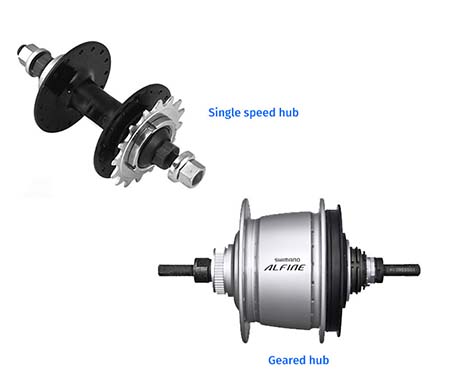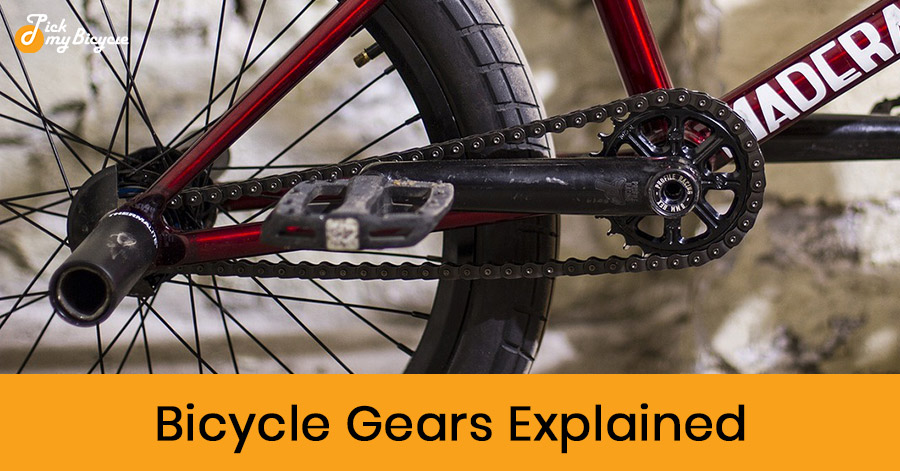How to Choose the Right Bicycle Gear?
Irresptive of the type of bike you use, gearing has a big impact on how fast and far you can ride, making it one of the most crucial things to get right if you want to get the most out of your riding. You risk being left behind as you spin out if your gears are too low, or too easy. If they're too high, you run the risk of not being able to pedal quickly enough when the going gets tough or coming to a halt while climbing a steep slope.
The basics of understanding your bike's gears are fairly straightforward - To make pedaling easier, push the lever one way; to go faster, push the lever the other way. However, picking the proper gear for your bike can be much trickier. It can be difficult to use bicycle gears when you're first starting out or haven't ridden in a while. However, knowing how to make the most of your gears and when to switch gears can be a transformative skill that makes cycling simpler.
Let's examine how gearing functions and how to select the appropriate gear for your discipline and terrain. We'll discuss how your gear ratios affect the amount of power you input, the significance of cadence, your options for gear ratios, and how to use your gear effectively.
How Do Bicycle Gears Work?
One of those wonderful inventions that make riding faster, easier to climb hills, and more enjoyable is the use of gears. The energy you expend on the pedals is translated into a specific output at the wheel by gears. Your muscles can only exert a certain amount of force, and there is typically a maximum cadence at which you will be most effective. You can advance more effectively by shifting gears in accordance with the terrain and environmental factors to stay primarily within that band. Bikes can change gears using a number of different systems, but the external drivetrain is by far the most popular.
Operate a Bike's Gears like Pro
You must identify the type of mechanism that shifts your gears in order to use your bike's gears properly. The various types of gear shifting mechanisms are numerous. These may consist of:
- Twist-grip shifters
- Shifts on the downtube
- Shifter at the bar
- Trigger switches
- Integrated brake and gear shift levers for the road
You will use your hands to operate each of the aforementioned gear mechanisms. Normally, you would want to put your bike in lower gear when climbing. You'll be able to pedal more easily as a result and climb the hill. On the other hand, shifting your bike will allow you to pedal quickly along a flat road.
1. Basic Gearing
Bicycle gearing is a remarkable invention, though we now take it for granted. Pedals and wheels on a bicycle can be moved at different speeds due to the chain drive, which was invented in the 1880s. Your rear wheel torque can be changed by adjusting your gearing.
2. Gear Ratios

Image source: https://www.quora.com/
This is known as the gear ratio because it is calculated by dividing the number of teeth on the cog by the number of teeth on the chainring. Taking a 52-tooth chainring and a 16-tooth cog as an example, the gear ratio is 3.25. As gear ratios increase, torque decreases, but speed increases. It is advantageous to have a high gear ratio when moving. During a sprint, you'll benefit from high gear ratios since you'll be moving quickly.
Low gear ratios are ideal for climbs because they cause your wheel to move more slowly but with more torque. This method is helpful for comparing the gearing on comparable bikes, but it ignores the role that wheel size plays. Add the external diameter of your wheel/tire (in inches) to the gear ratio of your chainring and cog to account for wheel size. As a result of one pedal rotation, you will know how far you bike will travel.
However, even gear inches do not account for crank length because longer or shorter crank arms alter the system's mechanical advantage. Moreover, efficiency is not taken into account, as it varies with sprocket size, chain angle, and other factors. The right gearing for your riding style and discipline is fairly straightforward if you keep a few important factors in mind.
3. Cycling Gearing
Double cranks of road bikes have three standard chainring sizes. In the past, most bikes came with a big chainring with 53 teeth and a small chainring with 39 teeth.
Road bike cassettes usually have 10 to 13 cogs, depending on the brand and drivetrain of your bike. Smaller cogs have 11 teeth. Larger cogs have 25–32 teeth. With the increasing differences between the smallest and largest cogs, gears become available in a more extensive range.
Individual preferences and equipment limitations determine the ideal gearing based on terrain and personal preferences. If it makes you ride more effectively and powerfully, it is not shameful to ride with easier gear.
4. A Road Climb's Gear

Easy gearing is the best choice if you're riding or competing in a hilly area because it enables you to maintain a faster cadence while climbing. If you know you'll be facing an unusual downhill sprint, having easier gears on a climb won't make much difference.
If the hills are not too steep and are moderately short (a few minutes or less), then a mid-compact crank is ideal. We recommend using a small crank for your long and steep climbs. In both cases, you will have an excellent gear ratio with a cassette with 28–32 teeth cogs. Ensure that your rear derailleur can handle the cogs you intend to use since some can only handle a certain size of cog.
5. Getting Ready for Flat Roads

The compact crankset is a great choice for flat terrain as well. When riding on flatter roads, riders can also use cassettes with smaller ranges than those required for climbing. Cassettes have the advantage of being a little lighter than cranks and having a subtler shift between gears, but they aren't ideal for hills. The number of individual cogs in modern drivetrains has increased to the point that even wide-range climbing cassettes offer mostly smooth transitions from cog to cog.
6. Young Gearing
Under-18 road race competitors have limited options for equipment. In this way, physical fit young people can compete against less developed competitors on a level playing field.
How to Choose the Right Gear According to Bike Type?
1. Cassettes

The group of gears at the back, commonly referred to as cogs, is a cassette. Cogs differ in size according to the ratio span. The range of the cassette increases with the size of the difference. The two pictures here, which come from Bike Rumor, show a wide and a narrow ratio cassette.
The Wide-ratio and Narrow ratio cassettes have distinct uses. When the terrain undulates, small steps between cogs can keep a rider at the "perfect" cadence. Wide steps enable more total range to be covered by the same number of cogs, which is necessary, for example, with 1X drivetrains. The trade-offs are significant, and there should be many considerations when choosing a cassette.
2. Geared hubs and single speeds

Ratio changes on geared hub bikes and single speeds are fairly simple. To get the desired ratio, adjust the front chainring or the back cog (or both). Changing the geared hub is the only practical way to change the overall ratio span (range), even though you can change the gear ratio either up or down.
3. Chainrings

The gears that are located close to the pedals are called chainrings or sprockets. Most contemporary bikes have one, two, or even three chainrings. These rings typically come in a variety of sizes, usually indicated by the number of teeth, and are typically separate components that can be changed fairly easily.
4. Derailleur

Image source: https://www.moldex3d.com/
Fortunately, "Derailleur" is relatively simple to comprehend even though it is difficult to pronounce. The front derailleur is a fairly basic piece of equipment that merely moves the chain from one chainring to the next, where it is picked up. Due to its dual functions, the rear derailleur is a little more complicated. In addition to guiding the chain from one cog to the next, it is also in charge of keeping the chain taut and picking up the slack when we shift from larger to smaller gears. The chain forms an "S" with the help of the rear derailleur's two tiny gears, which are actually called "pulleys."
Mountain Bikes Gearing

Mountain bikes once had triple cranks up front, much like road bikes do today, but almost all modern mountain bikes only have one chainring. With today's wide-range rear derailleurs, 1x drivetrains can achieve the same gear range as doubles and triples. Mountain bikers move more slowly overall and perform more climbing than road cyclists. Off-road, periods of descent are typically when the highest speeds are attained because pedaling is either difficult or impossible.
Selecting the Correct Gearing for Offroad
Beginner mountain bike racers typically use a chainring with 28 or 30 teeth. You can maintain steady power over others regardless of your level of experience significant terrain features is the most crucial factor. Sizing down is likely beneficial if your course includes a long, steep climb so that you can gain an advantage. A larger chainring might be a better choice if the course is primarily flat with only a few minor hills. There are also technical issues. Extreme angles reduce the efficiency of chains, so it is preferable to use gearing that promotes a straight chain line as frequently as possible.
Gearing for Cyclocross and Gravel

Combined with road gearing, gravel bikes and cross bikes balance the demands of riding on- and off-road. Single-ring setups are very common in both sports, and they share the same benefits of dependability and simplicity as mountain bikes. There are several choices of 1x chainring sizes for CX and gravel bikes; typically, they have 40 or 42 teeth, although riders can choose smaller or larger sizes based on their needs.
Gearing for gravel and cyclocross is heavily influenced by the terrain. The terrain and weather often affect the gearing in cyclocross competitions. Further, the chainring size can bring about slight changes in rear suspension kinematics. Chainrings with 32 teeth are common on full-suspension bikes. Most athletes barely notice the impact of the impact because it is typically minimal.
Frequently Asked Questions
1. How many bike gears you have?
The number of chainrings at the front is simply multiplied by the number of sprockets at the back. Therefore, a bicycle with a triple chainring setup with a 10-speed rear cassette is a 30-speed bike since all 10 sprockets can be used in conjunction with each of the three chainrings. A double chainring plus an 11-speed cassette together provide a 22-speed setup, and so on.
2. Why choose single speed bike gears?
Some people prefer single-speed cycles to bicycles with gears. Since single-speed bikes require less maintenance, they are popular among commuters who live in flat locations. They are also employed by some races, such as hill climbers, who aim to lose weight and reduce shifting-related complications; in these circumstances, selecting the right gear ratio is essential. Finally, track bikes always have one gear, however riders will alter their configuration to fit particular races.
3. How do gear shifters on road bikes function?
The location of the shift levers is not always readily apparent in some contemporary designs. Here are the fundamentals for the majority of mechanical gear sets currently on the market in case you have any questions; however, a nearby bike shop will go over this with you if you have any. Regardless of brand, the rear derailleur is controlled by the right-hand levers and the front by the left-hand levers. Electronic gears frequently operate differently, and some, like the most recent versions of Shimano Di2 and SRAM AXS, can even be customized to the rider's preferences.
Conclusion
Find a beautiful, calm stretch of road, and practice riding at various rhythms. This will help you understand your rhythm and get the proper gear on your bike. You count one foot making a complete rotation as one revolution. Adjust your cadence when getting out of the saddle by downshifting one gear (3928 to 3925). Most cyclists pedal between 80 and 90 revolutions per minute while seated and between 60 and 70 when standing. This rapid gear change will assist in getting you into your preferred climbing cadence range.
The same is true for climbs when the ideal cadence is often between 60 and 80 revolutions per minute. Once more, locate a peaceful hill and cycle up it at various cadences to see which one required the least amount of energy. You can then attempt climbs with various gradients, but always aim for the ideal cadence and choose the gear that will bring you there. There is no hard and fast rule, but in general, you should select a gear on a flat road that allows you to ride comfortably at the fastest possible speed for your level of fitness and to attain a cadence of roughly 90 RPM.

